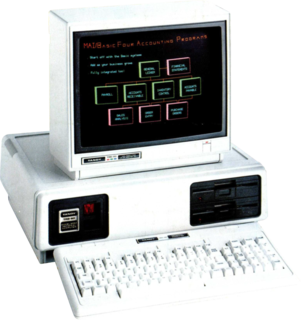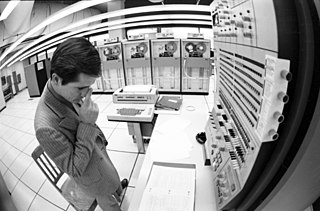Related Research Articles

The Motorola 68000 is a 16/32-bit complex instruction set computer (CISC) microprocessor, introduced in 1979 by Motorola Semiconductor Products Sector.

The 6800 is an 8-bit microprocessor designed and first manufactured by Motorola in 1974. The MC6800 microprocessor was part of the M6800 Microcomputer System that also included serial and parallel interface ICs, RAM, ROM and other support chips. A significant design feature was that the M6800 family of ICs required only a single five-volt power supply at a time when most other microprocessors required three voltages. The M6800 Microcomputer System was announced in March 1974 and was in full production by the end of that year.
The Motorola 68000 series is a family of 32-bit complex instruction set computer (CISC) microprocessors. During the 1980s and early 1990s, they were popular in personal computers and workstations and were the primary competitors of Intel's x86 microprocessors. They were best known as the processors used in the early Apple Macintosh, the Sharp X68000, the Commodore Amiga, the Sinclair QL, the Atari ST, the Sega Genesis, the Capcom System I (Arcade), the AT&T UNIX PC, the Tandy Model 16/16B/6000, the Sun Microsystems Sun-1, Sun-2 and Sun-3, the NeXT Computer, NeXTcube, NeXTstation, and NeXTcube Turbo, the Texas Instruments TI-89/TI-92 calculators, the Palm Pilot and the Space Shuttle. Although no modern desktop computers are based on processors in the 680x0 series, derivative processors are still widely used in embedded systems.

Lisa is a desktop computer developed by Apple, released on January 19, 1983. It is one of the first personal computers to present a graphical user interface (GUI) in a machine aimed at individual business users. Development of the Lisa began in 1978, and it underwent many changes during the development period before shipping at US$9,995 with a five-megabyte hard drive. Lisa was affected by its high price, insufficient software, unreliable Apple FileWare floppy disks, and the immediate release of the cheaper and faster Macintosh. Only 10,000 Lisas were sold in two years.

Xenix is a discontinued version of the Unix operating system for various microcomputer platforms, licensed by Microsoft from AT&T Corporation in the late 1970s. The Santa Cruz Operation (SCO) later acquired exclusive rights to the software, and eventually replaced it with SCO UNIX.

Apollo Computer Inc., founded in 1980 in Chelmsford, Massachusetts, by William Poduska and others, developed and produced Apollo/Domain workstations in the 1980s. Along with Symbolics and Sun Microsystems, Apollo was one of the first vendors of graphical workstations in the 1980s. Like computer companies at the time and unlike manufacturers of IBM PC compatibles, Apollo produced much of its own hardware and software.

Coherent is a clone of the Unix operating system for IBM PC compatibles and other microcomputers, developed and sold by the now-defunct Mark Williams Company (MWC). Historically, the operating system was a proprietary product, but it became open source in 2015, released under the BSD-3-Clause license.

The Tandy 2000 is a personal computer introduced by Radio Shack in September 1983 based on the 8 MHz Intel 80186 microprocessor running MS-DOS. By comparison, the IBM PC XT used the older 4.77 MHz Intel 8088 processor, and the IBM PC AT would later use the newer 6 MHz Intel 80286. Due to the 16-bit-wide data bus and more efficient instruction decoding of the 80186, the Tandy 2000 ran significantly faster than other PC compatibles, and slightly faster than the PC AT. The Tandy 2000 was the company's first computer built around an Intel x86 series microprocessor; previous models used the Zilog Z80 and Motorola 6809 CPUs.
The Acorn Business Computer (ABC) was a series of microcomputers announced at the end of 1983 by the British company Acorn Computers. The series of eight computers was aimed at the business, research and further education markets. Demonstrated at the Personal Computer World Show in September 1984, having been under development for "about a year" and having been undergoing field trials from May 1984, the range "understandably attracted a great deal of attention" and was favourably received by some commentators. The official launch of the range was scheduled for January 1985.

The Professional 325 (PRO-325), Professional 350 (PRO-350), and Professional 380 (PRO-380) were PDP-11 compatible microcomputers introduced in 1982 by Digital Equipment Corporation (DEC) as high-end competitors to the IBM PC.

Venix is a discontinued version of the Unix operating system for low-end computers, developed by VenturCom, a "company that specialises in the skinniest implementations of Unix".
Interactive Systems Corporation was a US-based software company and the first vendor of the Unix operating system outside AT&T, operating from Santa Monica, California. It was founded in 1977 by Peter G. Weiner, a RAND Corporation researcher who had previously founded the Yale University computer science department and had been the Ph. D. advisor to Brian Kernighan, one of Unix's developers at AT&T. Weiner was joined by Heinz Lycklama, also a veteran of AT&T and previously the author of a Version 6 Unix port to the LSI-11 computer.
Since the rise of the personal computer in the 1980s, IBM and other vendors have created PC-based IBM-compatible mainframes which are compatible with the larger IBM mainframe computers. For a period of time PC-based mainframe-compatible systems had a lower price and did not require as much electricity or floor space. However, they sacrificed performance and were not as dependable as mainframe-class hardware. These products have been popular with mainframe developers, in education and training settings, for very small companies with non-critical processing, and in certain disaster relief roles.

Following the introduction of the IBM Personal Computer, or IBM PC, many other personal computer architectures became extinct within just a few years. It led to a wave of IBM PC compatible systems being released.

The history of the personal computer as a mass-market consumer electronic device began with the microcomputer revolution of the 1970s. A personal computer is one intended for interactive individual use, as opposed to a mainframe computer used by enterprises where the end user's requests are filtered through operating staff, or a time-sharing system in which one large processor is shared by many individuals. After the development of the microprocessor, individual personal computers were low enough in cost that they eventually became affordable consumer goods. Early personal computers – generally called microcomputers – were sold often in electronic kit form and in limited numbers, and were of interest mostly to hobbyists and technicians.
CADO Systems was a minicomputer and software manufacturer in 1976. In 1983 was acquired by Contel Business Systems. In 1989 Contel Business Systems merged with NDS and became VERSYSS. CADO was formed by former staff of McDonnell-Douglas Information Systems. CADO was based in Torrance Ca. and had a manufacturing plant and systems software engineering team in Cork, Ireland.

The TRS-80 Model II is a computer system launched by Tandy in October 1979, and targeted at the small-business market. It is not an upgrade of the original TRS-80 Model I, but a new system.

Altos Computer Systems was founded in 1977 by David G. Jackson and Roger William Vass Sr. It focused on small multi-user computers, starting with multi-user derivatives of CP/M, and later including Unix and Xenix-based machines. In its 1982 initial public offering on NASDAQ, the company raised $59M. Thereafter the company's stock was traded under the symbol ALTO.
In computer architecture, 16-bit integers, memory addresses, or other data units are those that are 16 bits wide. Also, 16-bit central processing unit (CPU) and arithmetic logic unit (ALU) architectures are those that are based on registers, address buses, or data buses of that size. 16-bit microcomputers are computers that use 16-bit microprocessors.
References
- 1 2 "The IBM CS-9000 Instrument Computer". Columbia Univ. Computing History.
- ↑ The Enhanced IBM System 9000 Computer IBM ad in Chem. Eng. News, March 26, 1984, 62 (13), pp 17–19
- 1 2 BYTE Guide to the IBM PC, fall 1984, p.26
- 1 2 3 Clune, Thomas R. (February 1984). "The IBM CS-9000 Lab Computer". BYTE. p. 278. Retrieved 9 March 2016.
- ↑ Derfler, Frank J. Jr. (20 March 1984). "PC's Powerful Cousin: The IBM CS9000". PC Magazine . Vol. 3, no. 5. pp. 170–174.
- ↑ "Old-Computers.com collection". Archived from the original on 2009-11-24. Retrieved 2011-08-18.
- ↑ http://www.old-computers.com/museum/doc.asp?c=623&st=1 oral history
- 1 2 Morgan, Chris (January 1983). "IBM's "Secret" Computer". BYTE. p. 108. Retrieved 19 October 2013.
- ↑ "IBM Announces Science Micro". P-Communications. PC Magazine . Vol. 1, no. 6. October 1982. p. 30.
- 1 2 3 4 5 Wallace, Richard (20 January 1986). "IBM Stops 9000 Series Production". Electronic News .
- ↑ Congress, Library of; Office For Subject Cataloging Policy, Library of Congress (1998). "Library of Congress Subject Headings".
{{cite web}}:|last2=has generic name (help) - ↑ Gens, Frank; Christiansen, Chris (November 1983). "Could 1,000,000 IBM PC Users Be Wrong?". BYTE. p. 135. Retrieved 19 March 2016.
- ↑ International Business Machines Corporation (February 21, 1984). Announcement Letter 1984-022.
- ↑ Henkel, Tom (5 March 1984). "IBM moves System 9000 into corporate sector". Computerworld . Vol. XVIII, no. 10. pp. 79, 82.
- ↑ Henkel, Tom (5 March 1984). "What IBM's move means to users". Micro Bits. Computerworld . Vol. XVIII, no. 10. pp. 79, 81.
- ↑ "IBM System 9003 for manufacturing out". Microcomputers. Computerworld . Vol. XIX, no. 17. 29 April 1985. p. 48.
- ↑ IBM Announcement Letter Number 186-165
- ↑ IBM to Shut Instrument Unit, Technology section, New York Times, January 9, 1987
- ↑ "A bright new world for dealers". The DEC professional. November 1983. p. 19.
- ↑ "General Software Enhancements for IBM System 9000". IBM . 1984-08-21.
The IBM 9000 C Compiler is derived from Kernighan and Ritchie (1978) and produces optimized, native 68000 code directly from C source code.